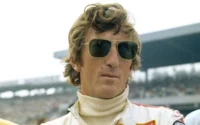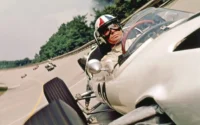Austrian Jochen Rindt was an F1 driver who competed from 1964 until he died in 1970. Rindt is the only driver to have been posthumously awarded the Drivers’ Championship, which he won in 1970 while racing for Lotus. He tragically died during practice for the Italian Grand Prix that same year. Alongside his F1 accolades, Rindt also claimed victory at the 24 Hours of Le Mans in 1965
| Nationality | Austrian |
|---|---|
| Born | Karl Jochen Rindt 18 April 1942 Mainz, Volksstaat Hessen, German Reich |
| Died | 5 September 1970 (aged 28) Autodromo Nazionale Monza, Lombardy, Italy |
Born in Germany but raised in Austria, Rindt began racing in 1961. He moved to single-seaters in 1963 in Formula Junior and Formula Two. Rindt made his F1 debut at the 1964 Austrian Grand Prix and secured a full-time seat with Cooper in 1965. After mixed results, he joined Brabham in 1968 before moving to Lotus in 1969. With Lotus, Rindt secured his first Formula One victory at the 1969 United States Grand Prix and had a standout 1970 season, winning five of the first nine races, mainly driving the innovative Lotus 72.
Rindt’s fatal accident happened during practice for the 1970 Italian Grand Prix at Monza when his car’s brake shaft failed, causing him to crash into the barriers. A poorly installed crash barrier contributed to his fatal injuries, and he was pronounced dead en route to the hospital. Despite his passing, his points tally was enough to secure the World Championship, as his nearest rival, Jacky Ickx, couldn’t score enough in the remaining races to beat him to the title. Rindt left behind his wife, Nina, and their daughter, Natasha.
Until his death, Rindt had taken part in 62 Grand Prix, winning six and earning 13 podium finishes. Beyond Formula One, he also found success in sports car racing, with victory at the 1965 Le Mans alongside Masten Gregory in a Ferrari 250LM. Rindt’s popularity in Austria helped increase an interest in motorsport, particularly Formula One. He even hosted a television show, Motorama. During his time in the sport, he actively supported efforts to improve Formula One safety, working alongside fellow driver Jackie Stewart.
Jochen Rindt Formula One World Championship career
| F1 Career | 1964–1970 |
|---|---|
| Teams | Rob Walker (Privateer Brabham), Cooper, Brabham, Lotus |
| Entries | 62 (60 starts) |
| Championships | 1 (1970) |
| Wins | 6 |
| Podiums | 13 |
| Career points | 107 (109) |
| Pole positions | 10 |
| Fastest laps | 3 |
| First entry | 1964 Austrian Grand Prix |
| First win | 1969 United States Grand Prix |
| Last win | 1970 German Grand Prix |
| Last entry | 1970 Italian Grand Prix |
Jochen Rindt Teammates
| 17 Teammates | Involvement | First Year | Last Year |
|---|---|---|---|
| Jo Bonnier | 1 | 1964 | |
| Bruce McLaren | 10 | 1965 | |
| Richie Ginther | 2 | 1966 | |
| John Surtees | 7 | 1966 | |
| Chris Amon | 2 | 1966 | |
| Moises Solana | 2 | 1966 | |
| Pedro Rodriguez | 8 | 1967 | |
| Alan Rees | 1 | 1967 | |
| Richard Attwood | 1 | 1967 | |
| Jacky Ickx | 2 | 1967 | |
| Jack Brabham | 12 | 1968 | |
| Dan Gurney | 1 | 1968 | |
| Mario Andretti | 4 | 1969 | |
| Graham Hill | 10 | 1969 | |
| John Miles | 15 | 1969 | 1970 |
| Alex Soler-Roig | 1 | 1970 | |
| Emerson Fittipaldi | 4 | 1970 |
Race Wins
| Win Number | Grand Prix |
|---|---|
| 1 | 1969 United States Grand Prix |
| 2 | 1970 Monaco Grand Prix |
| 3 | 1970 Dutch Grand Prix |
| 4 | 1970 French Grand Prix |
| 5 | 1970 British Grand Prix |
| 6 | 1970 German Grand Prix |
Complete Formula One Results
| Year | Entrant | Chassis | Engine | 1 | 2 | 3 | 4 | 5 | 6 | 7 | 8 | 9 | 10 | 11 | 12 | 13 | WDC | Pts1 |
|---|---|---|---|---|---|---|---|---|---|---|---|---|---|---|---|---|---|---|
| 1964 | Rob Walker Racing Team | Brabham BT11 | BRM P56 1.5 V8 | MON | NED | BEL | FRA | GBR | GER | AUT Ret | ITA | USA | MEX | NC | 0 | |||
| 1965 | Cooper Car Company | Cooper T73 | Climax FWMV 1.5 V8 | RSA Ret | ITA 8 | 13th | 4 | |||||||||||
| Cooper T77 | Climax FWMV 1.5 V8 | MON DNQ | BEL 11 | FRA Ret | GBR 14 | NED Ret | GER 4 | USA 6 | MEX Ret | |||||||||
| 1966 | Cooper Car Company | Cooper T81 | Maserati 9/F1 3.0 V12 | MON Ret | BEL 2 | FRA 4 | GBR 5 | NED Ret | GER 3 | ITA 4 | USA 2 | MEX Ret | 3rd | 22 (24) | ||||
| 1967 | Cooper Car Company | Cooper T81 | Maserati 9/F1 3.0 V12 | RSA Ret | MON Ret | CAN Ret | 13th | 6 | ||||||||||
| Cooper T81B | Maserati 9/F1 3.0 V12 | NED Ret | ||||||||||||||||
| Cooper T81B | Maserati 10/F1 3.0 V12 | BEL 4 | FRA Ret | USA Ret | MEX | |||||||||||||
| Cooper T86 | Maserati 10/F1 3.0 V12 | GBR Ret | GER Ret | ITA 4 | ||||||||||||||
| 1968 | Brabham Racing Organisation | Brabham BT24 | Repco 740 3.0 V8 | RSA 3 | ESP Ret | MON Ret | 12th | 8 | ||||||||||
| Brabham BT26 | Repco 860 3.0 V8 | BEL Ret | NED Ret | FRA Ret | GBR Ret | GER 3 | ITA Ret | CAN Ret | USA Ret | MEX Ret | ||||||||
| 1969 | Gold Leaf Team Lotus | Lotus 49B | Ford Cosworth DFV 3.0 V8 | RSA Ret | ESP Ret | MON | NED Ret | FRA Ret | GBR 4 | GER Ret | ITA 2 | CAN 3 | USA 1 | MEX Ret | 4th | 22 | ||
| 1970 | Gold Leaf Team Lotus | Lotus 49C | Ford Cosworth DFV 3.0 V8 | RSA 13 | MON 1 | BEL Ret | 1st | 45 | ||||||||||
| Lotus 72 | Ford Cosworth DFV 3.0 V8 | ESP Ret | ||||||||||||||||
| Lotus 72C | Ford Cosworth DFV 3.0 V8 | NED 1 | FRA 1 | GBR 1 | GER 1 | AUT Ret | ITA DNS | CAN | USA | MEX |
Sources:
- Jochen Rindt. Wikipedia.com
- statsf1.com


